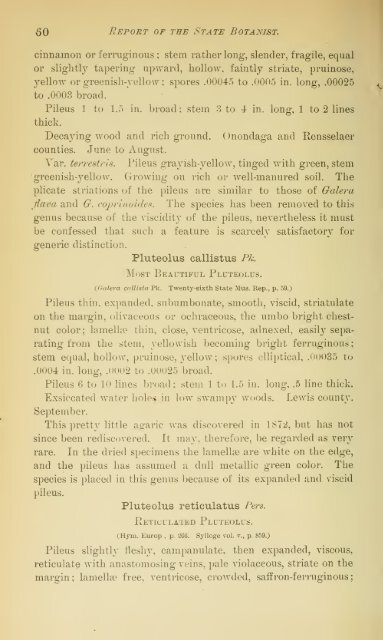Annual Report of the State Botanist 1892 - MykoWeb
Annual Report of the State Botanist 1892 - MykoWeb
Annual Report of the State Botanist 1892 - MykoWeb
You also want an ePaper? Increase the reach of your titles
YUMPU automatically turns print PDFs into web optimized ePapers that Google loves.
60<br />
cinnamon or ferruginous ;<br />
<strong>Report</strong> <strong>of</strong> <strong>the</strong> <strong>State</strong> <strong>Botanist</strong>.<br />
stem ra<strong>the</strong>r long, slender, fragile, equal<br />
or slightly tapering upward, hollow, faintly striate, pruinose,<br />
yellow or greenish-yellow ; spores .00045 to .0005 in. long, .00025<br />
to .0003 broad.<br />
Pileus 1 to 1.5 in. broad ; stem 3 to 4 in. long, 1 to 2 lines<br />
thick.<br />
Decaying wood and rich ground. ( )nondaga and Rensselaer<br />
counties. June to August.<br />
Var. terrestris. Pileus grayish-yellow, tinged with green, stem<br />
greenish-yellow. Growing on rich or well-manured soil. The<br />
plicate striations <strong>of</strong> <strong>the</strong> pileus are similar to those <strong>of</strong> Galera<br />
flava and G. coprinoides. The species has been removed to this<br />
genus because <strong>of</strong> <strong>the</strong> viscidity <strong>of</strong> <strong>the</strong> pileus, never<strong>the</strong>less it must<br />
be confessed that such a feature is scarcely satisfactory for<br />
generic distinction.<br />
Pluteolus callistus Pk.<br />
Most Beautiful Pluteolus.<br />
(^Galera calUsta Pk. Twenty-sixth <strong>State</strong> Mus. Rep., p. 59.)<br />
Pileus thin, expanded, subumbonate, smooth, viscid, striatulate<br />
on <strong>the</strong> margin, olivaceous or ochraceous, <strong>the</strong> umbo bright chest-<br />
nut color; lamellse thin, close, ventricose, adnexed, easily sepa-<br />
rating from <strong>the</strong> stem, yellowish becoming bright ferruginous<br />
stem equal, hollow, pruinose, yellow ; spores elliptical, .00035 to<br />
.0004 in. long, .0002 to .00025 broad.<br />
Pileus 6 to 10 lines broad ; stem 1 to 1.5 in. long, ,5 line thick.<br />
Exsiccated water holes in low swampy woods. Lewis county.<br />
September.<br />
This pretty little agaric was discovered in 1872, but has not<br />
since been rediscovered. It may, <strong>the</strong>refore, be regarded as very<br />
rare. In <strong>the</strong> dried specimens <strong>the</strong> lameUae are white on <strong>the</strong> edge,<br />
and <strong>the</strong> pileus has assumed a dull metallic green color. The<br />
species is placed in this genus because <strong>of</strong> its expanded and viscid<br />
pileus.<br />
Pluteolus reticulatus Pers.<br />
Reticulated Pluteolus.<br />
(Hym. Europ , p. 2G6. Sylloge vol. v., p. 859.)<br />
Pileus slightly fleshy, campanulate, <strong>the</strong>n expanded, viscous,<br />
reticulata with anastomosing veins, pale violaceous, striate on <strong>the</strong><br />
margin; lamellae free, ventricose, crowded, saffron-ferruginous;<br />
;
















